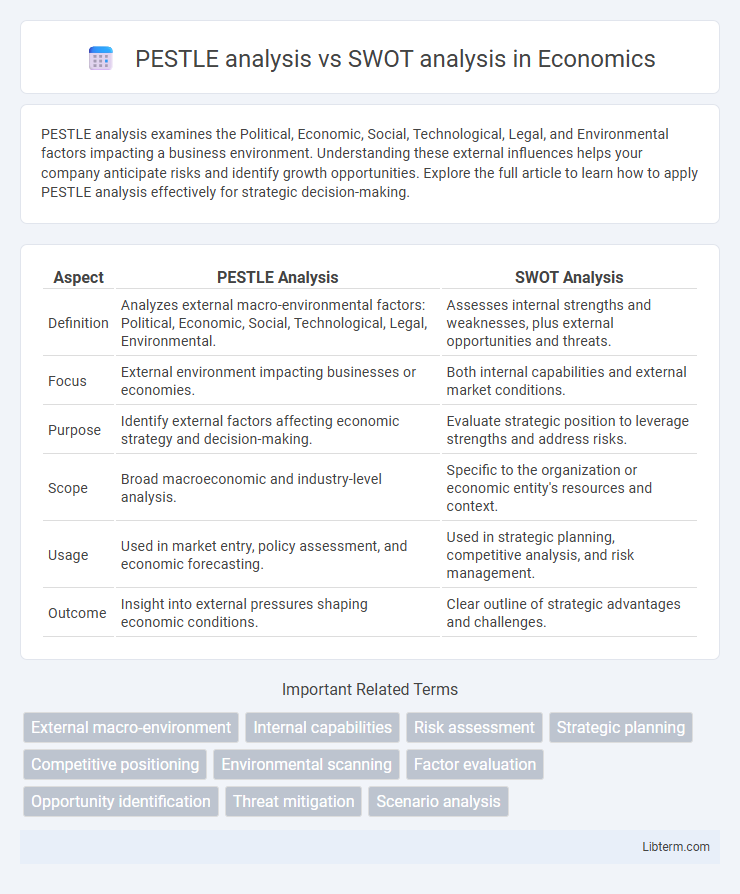PESTLE analysis examines the Political, Economic, Social, Technological, Legal, and Environmental factors impacting a business environment. Understanding these external influences helps your company anticipate risks and identify growth opportunities. Explore the full article to learn how to apply PESTLE analysis effectively for strategic decision-making.
Table of Comparison
| Aspect | PESTLE Analysis | SWOT Analysis |
|---|---|---|
| Definition | Analyzes external macro-environmental factors: Political, Economic, Social, Technological, Legal, Environmental. | Assesses internal strengths and weaknesses, plus external opportunities and threats. |
| Focus | External environment impacting businesses or economies. | Both internal capabilities and external market conditions. |
| Purpose | Identify external factors affecting economic strategy and decision-making. | Evaluate strategic position to leverage strengths and address risks. |
| Scope | Broad macroeconomic and industry-level analysis. | Specific to the organization or economic entity's resources and context. |
| Usage | Used in market entry, policy assessment, and economic forecasting. | Used in strategic planning, competitive analysis, and risk management. |
| Outcome | Insight into external pressures shaping economic conditions. | Clear outline of strategic advantages and challenges. |
Introduction to Strategic Analysis Tools
PESTLE analysis examines external macro-environmental factors including Political, Economic, Social, Technological, Legal, and Environmental influences that impact business strategy development. SWOT analysis evaluates internal Strengths and Weaknesses alongside external Opportunities and Threats to provide a holistic view of organizational capabilities and market conditions. Combining PESTLE and SWOT analyses enhances strategic decision-making by aligning internal resources with external environmental challenges and opportunities.
What is PESTLE Analysis?
PESTLE analysis is a strategic tool used to evaluate external environmental factors affecting an organization, including Political, Economic, Social, Technological, Legal, and Environmental elements. This framework helps businesses identify potential opportunities and threats in the macro-environment to inform decision-making and long-term planning. Unlike SWOT analysis, which assesses internal strengths and weaknesses alongside external opportunities and threats, PESTLE focuses exclusively on external factors shaping market dynamics.
Key Components of PESTLE Analysis
PESTLE analysis focuses on six key components: Political, Economic, Social, Technological, Legal, and Environmental factors, providing a comprehensive external macro-environmental overview. SWOT analysis, by contrast, centers on internal Strengths and Weaknesses alongside external Opportunities and Threats, offering a more balanced internal-external perspective. The distinct emphasis on external environmental scanning in PESTLE enables businesses to anticipate market trends, regulatory changes, and socio-economic shifts more effectively.
What is SWOT Analysis?
SWOT Analysis is a strategic planning tool used to identify an organization's internal Strengths and Weaknesses, as well as external Opportunities and Threats. It provides a comprehensive framework for assessing competitive advantages and potential challenges in the business environment. Unlike PESTLE analysis, which examines macro-environmental factors, SWOT focuses more on internal capabilities and immediate market conditions.
Key Components of SWOT Analysis
SWOT analysis focuses on four key components: Strengths, Weaknesses, Opportunities, and Threats, providing a comprehensive internal and external overview of a business's strategic position. Strengths and weaknesses assess internal factors such as resources, capabilities, and processes, while opportunities and threats analyze external market conditions, competition, and trends. This method contrasts with PESTLE analysis, which specifically examines external macro-environmental factors--Political, Economic, Social, Technological, Legal, and Environmental--that influence an organization's performance.
PESTLE Analysis: Strengths and Limitations
PESTLE analysis offers a comprehensive framework by examining Political, Economic, Social, Technological, Legal, and Environmental factors that influence business strategy, enabling organizations to anticipate external challenges and opportunities. Its strength lies in providing a broad external environment overview, which helps in strategic planning and risk management across multiple domains. Limitations include its potential for information overload and a lack of focus on internal capabilities, making it less effective than SWOT analysis in assessing organizational strengths and weaknesses.
SWOT Analysis: Strengths and Limitations
SWOT analysis identifies internal strengths such as skilled workforce, strong brand reputation, and robust financial resources, which help organizations leverage competitive advantages. Its limitations include its subjective nature and potential oversimplification of complex strategic issues, making it less effective in dynamic market environments. Unlike PESTLE analysis, which examines external macro-environmental factors like political, economic, social, technological, legal, and environmental influences, SWOT focuses primarily on internal capabilities and immediate external opportunities and threats.
Major Differences Between PESTLE and SWOT
PESTLE analysis examines external macro-environmental factors--Political, Economic, Social, Technological, Legal, and Environmental--that impact an organization's strategic planning, while SWOT analysis evaluates internal strengths and weaknesses alongside external opportunities and threats. PESTLE provides a broader contextual framework for understanding external influences, whereas SWOT offers a balanced internal-external perspective to identify strategic priorities. The distinction lies in PESTLE's focus on environmental scanning and SWOT's role in direct organizational assessment and decision-making.
When to Use PESTLE vs. SWOT
PESTLE analysis is ideal for examining the external macro-environmental factors affecting an organization, including Political, Economic, Social, Technological, Legal, and Environmental influences, making it useful during strategic planning or market entry. SWOT analysis focuses on identifying internal Strengths and Weaknesses alongside external Opportunities and Threats, helping organizations capitalize on competitive advantages and address challenges. Use PESTLE when assessing broad external conditions affecting the business environment, and apply SWOT when evaluating specific strategic options based on internal capabilities and external market conditions.
Conclusion: Choosing the Right Analysis Tool
PESTLE analysis focuses on external macro-environmental factors such as political, economic, social, technological, legal, and environmental influences, making it ideal for strategic planning in dynamic markets. SWOT analysis evaluates internal strengths and weaknesses alongside external opportunities and threats, providing a comprehensive overview for operational decision-making. Selecting the right tool depends on whether the emphasis is on external environmental scanning (PESTLE) or internal capability assessment combined with external factors (SWOT).
PESTLE analysis Infographic

 libterm.com
libterm.com